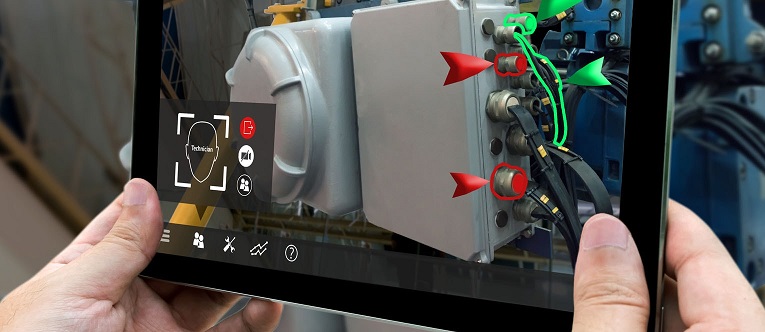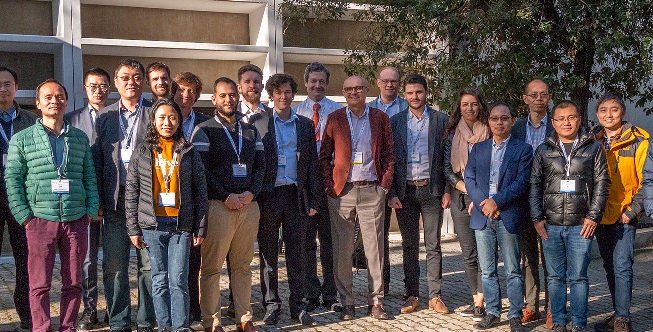ETSI unveils Augmented Reality framework enabling multi-vendor ecosystem for industry and consumers
The ETSI Industry Specification Group on the Augmented Reality Framework (ISG ARF) unveils ETSI GS ARF 003, a key specification towards the interoperability of AR components. Today industrial and end users tend to frequently depend on a single provider to deploy AR applications and services. Compliance with the ETSI framework will allow components from different providers to interoperate via the defined interfaces, allowing broader and quicker adoption of AR technology. It will also take account of a growing and dynamic AR market.
The ETSI GS ARF 003 introduces the characteristics of an AR system and describes the functional building blocks of a generic AR reference architecture and their mutual relationships. The global architecture gives an overview of an AR system which is based on a set of hardware and software components as well as data describing the real world and virtual content. The functional architecture applies to both fully embedded AR systems and implementations spread over IP networks in a scalable manner with subfunctions. These subfunctions can either be deployed on the AR device or be provided via cloud technology.
ETSI releases a technical report on Autonomic Network Management and Control applying Machine Learning and other AI Algorithms
The ETSI Technical Committee on Core Network and Interoperability Testing (TC INT) has just released a Technical Report, ETSI TR 103 626, providing a mapping of architectural components for autonomic networking, cognitive networking and self-management. This architecture will serve the self-managing Future Internet. The ETSI TR 103 626 provides a mapping of architectural components developed in the European Commission (EC) WiSHFUL and ORCA Projects, using the ETSI Generic Autonomic Networking Architecture (GANA) model. The objective is to illustrate how the ETSI GANA model specified in the ETSI specification TS 103 195-2 can be implemented when using the components developed in these two projects. The Report also shows how the WiSHFUL architecture augmented with virtualization and hardware acceleration techniques can implement the GANA model. This will guide implementers of autonomics components for autonomic networks in their optimization of their GANA implementations.
The TR addresses autonomic decision-making and associated control-loops in wireless network architectures and their associated management and control architectures. The mapping of the architecture also illustrates how to implement self-management functionality in the GANA model for wireless networks, taking into consideration another Report ETSI TR 103 495, where GANA cognitive algorithms for autonomics, such as machine learning and other AI algorithms, can be applied.
ETSI announced the launch of a new group dedicated to specifying the fifth generation of Fixed Network (ETSI ISG F5G). In a launch via an online press and industry briefing yesterday, various speakers expressed their view on the need for standardization in this area. We are entering an exciting new era of communications, and fixed networks play an essential role in that evolution alongside and in cooperation with mobile networks. Building on previous generations of fixed networks, the 5th generation will address three main use cases, a full-fiber connection, enhanced fixed broadband and a guaranteed reliable experience.
For home scenarios, emerging services such as Cloud VR (virtual reality) and AR (augmented reality) video streaming or online gaming introduce the necessity for ultra-broadband, extremely low latency and zero packet loss. Business scenarios such as enterprise Cloudification, leased line, or POL (Passive Optical LAN) require high reliability and high security. Other industry sectors have specific requirements on the deployment of fiber infrastructures including environmental conditions such as humidity, temperature or electromagnetic interference.
ETSI Issues Two Major Standards for Emergency Calls: Next Generation 112 and Advanced Mobile Location
ETSI’s Emergency Communication Special Committee has recently released two major specifications, ETSI TS 103 479, for NG112, the next generation of European emergency services and ETSI TS 103 625, for the specific Advanced Mobile Location function. AML is already implemented in 22 countries worldwide following the publication of the first ETSI technical report TR 103 393.
NEXT GENERATION OF EMERGENCY CALLS: ETSI TS 103 479 specifies the core elements of the architecture for network independent access to emergency services, enabling interoperability of implementation for the Next Generation access to emergency services. Next Generation 112 (NG112) architecture enables multimedia communications (text, video, together with location or additional data) which is not possible on the current phone-based system. This will benefit citizens in emergency situations as well as emergency responders, network providers and other stakeholders.
ADVANCED MOBILE LOCATION: As more than 70% of emergency calls come from a mobile phone in Europe, the Advanced Mobile Location (AML) technology is essential to provide the most accurate location of the caller. With AML the phone's location capabilities (making use of GNSS, WIFI and cellular network information) are activated when an emergency number is dialed. The location obtained is then sent to a location endpoint managed by, or on behalf of, a national emergency service. These technologies can provide a location precision as good as 5m outdoors (and averaging to within circular areas of ~25 m radius for indoor locations), a significant improvement on existing cell coverage provided by mobile networks, which average (across the UK as an example) circular areas of about 1,75 km radius.
The ETSI Technical Committee on Electronic Signatures and Infrastructures (TC ESI) is pleased to release the ETSI TR 103684 technical report. This report addresses existing trust service infrastructures that operate in different regions of the world and their possible mutual recognition/global acceptance. The report identifies ways to facilitate cross recognition between EU trust services and trust services from other schemes. The trust services are based on ETSI standards and support the eIDAS Regulation (EU) No 910/2014.
ETSI TR 103 684 concentrates on existing PKI-based trust services, the most prevalent across the world. The study analyzed 37 global, sector and national public key infrastructure schemes and involved workshops held in 4 regions of the world in Dubai, Tokyo, Mexico City and New York. The methodology covered four main elements of a trust service: legal context, supervision and audit, technical standards, and trust representation. The study highlighted a strong interest with achieving mutual recognition of trust services with the EU in all the regions of the world visited.
The ETSI Multi-access Edge Computing Industry Specification Group is pleased to announce the release of two major reports as part of its Phase 2 work. The report ETSI GR MEC 027 studies the impact of alternative virtualization technologies. The second report, ETSI GR MEC 024, examines network slicing on edge computing systems.
ETSI GR MEC 027, a report on alternative virtualization technologies, identifies the additional support that needs to be provided when MEC applications run on containers. Building on related work developed by the ETSI NFV group, it defines the usage of such technologies in a MEC environment, the impact on implementation of MEC systems and applications and the potential updates of future ETSI MEC standards. The results and conclusion of this report highlight that most of the ETSI MEC specifications are virtualization-technology agnostic; this leads to very few updates of existing standards.
ETSI GR MEC 024 identifies the MEC functionalities to support network slicing and the impact on future ETSI MEC specifications. It provides important use cases and examples of how network slicing may be addressed in edge computing systems. One of them includes the description, use case recommendations and evaluation of a network slice integrating MEC applications and using 3GPP elements. Other use cases address how you can have multiple tenants in a network slice or how efficient an end-to-end multi-slice support for MEC-enabled 5G deployments can be. Four network slicing concepts have been described and two prioritized for the time being.











